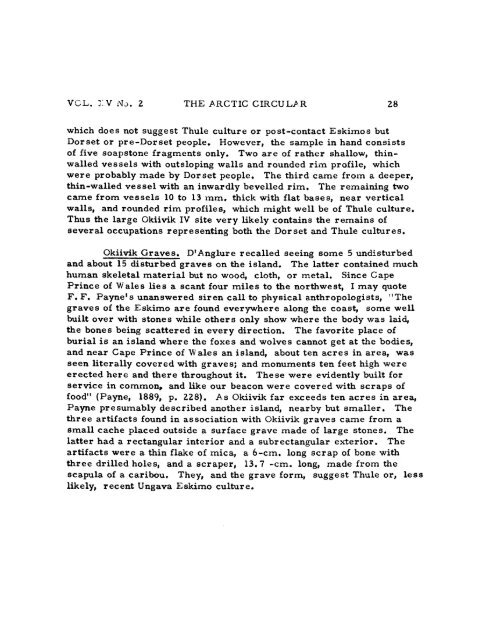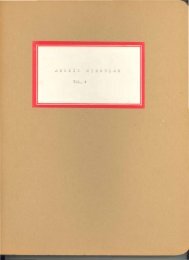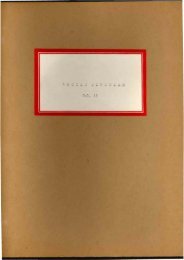A RCTIC CIRCULA NO. I Notes on a trip in l6-foot ... - The Arctic Circle
A RCTIC CIRCULA NO. I Notes on a trip in l6-foot ... - The Arctic Circle
A RCTIC CIRCULA NO. I Notes on a trip in l6-foot ... - The Arctic Circle
Create successful ePaper yourself
Turn your PDF publications into a flip-book with our unique Google optimized e-Paper software.
VOL. ). V f[;. ?, THE A<str<strong>on</strong>g>RCTIC</str<strong>on</strong>g> <str<strong>on</strong>g>CIRCULA</str<strong>on</strong>g>R z8<br />
which does not suggest Thule culture or post-c<strong>on</strong>tact Eskimos but<br />
Dorset or pre-Dorset people, However, the sample <strong>in</strong> hand c<strong>on</strong>sists<br />
of five soapst<strong>on</strong>e fragments <strong>on</strong>ly. Two are of rather shallow, th<strong>in</strong>walled<br />
vessels with outslop<strong>in</strong>g walls and rounded rim profile, which<br />
were probably rnade by Dorset people. <strong>The</strong> tbird carne from a deeper,<br />
th<strong>in</strong>-walIed vessel with an <strong>in</strong>wardly bevelled rim. <strong>The</strong> rema<strong>in</strong><strong>in</strong>g two<br />
came frorn vessels l0 to 13 mm. thick with flat bases, near vertical<br />
walls, and rounded rim profiles, which might well be of Thule culture.<br />
Thus the large Okiivik IV site very likely c<strong>on</strong>ta<strong>in</strong>s tJre rerna<strong>in</strong>s of<br />
several occupati<strong>on</strong>s represent<strong>in</strong>g both the Dorset and Thule culhrres.<br />
Okiivik Graves. DrAnglure recalled see<strong>in</strong>g some 5 undisturbed<br />
and"uo@rave8<strong>on</strong>theis1and.<strong>The</strong>1atterc<strong>on</strong>ta<strong>in</strong>edmuch<br />
human skeletal material but no wood, cloth, or metal. S<strong>in</strong>ce Cape<br />
Pr<strong>in</strong>ce of W ales lies a scant four miles to the northwest, I may quote<br />
F. F . Payner s unanswered siren call to phyeical anthropologists, 'f <strong>The</strong><br />
graves of the Eskirno are found everywhere al<strong>on</strong>g the coast, some well<br />
built over with st<strong>on</strong>es while others <strong>on</strong>ly show where the body was laid<br />
tbe b<strong>on</strong>es be<strong>in</strong>g scattered <strong>in</strong> every directi<strong>on</strong>. <strong>The</strong> favorite place of<br />
burial is an island where the foxes and wolves cannot get at the bodies,<br />
and near Cape Pr<strong>in</strong>ce of W ales an island, about ten acres <strong>in</strong> area, was<br />
seen literally covered with graves; and m<strong>on</strong>urnents ten feet high were<br />
erected here and there throughout it. <strong>The</strong>se were evidently built for<br />
service <strong>in</strong> comrroDp and like our beac<strong>on</strong> were covered witb scraps of<br />
food'r (Payne, 1889, p. ZZ8l. As Okiivik far exceeds ten acres <strong>in</strong> area,<br />
Payne presurnably described another island, nearby but smaller. <strong>The</strong><br />
three artifacts found <strong>in</strong> associati<strong>on</strong> with Okiivik graves carre frorn a<br />
small cache placed outeide a surface grave rnade of large st<strong>on</strong>es. <strong>The</strong><br />
latter bad a rectangular <strong>in</strong>terior and a subrectangular exterior. <strong>The</strong><br />
artifacts were a th<strong>in</strong> flake of mica, a 6-cm. l<strong>on</strong>g scrap of b<strong>on</strong>e with<br />
tJrree drilled holes, and a scraper, L3. 7 -cnl. l<strong>on</strong>g, made from the<br />
scapula of a caribou, <strong>The</strong>n and the grave form, suggest Thule or, less<br />
likely, recent Ungava Eskirno culhrre.












